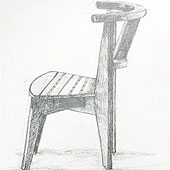The course has introduced varieties of techniques for communicating or representing ideas/concepts on paper. The main areas of presentation are outlined below:
1. Preliminary Sketches
2. Development Sketches
3. Working Drawings
4. Presentation Drawings
These stages describe the whole design process from the finest thoughts and ideas about a problem to the final rendered solution.
1. Preliminary Sketches:
This stage includes-a simple investigation of the problem, research notes and sketches, a series of annotated sketches (sketches and notes) outlining initial level of thoughts and ideas.
Annotated sketches help in representing/ externalizing information and ideas down on paper.
• Sketches are used to convey information related to shape, form and overall appearance.
• Notes are added for indicating possible details such as fixing methods, manufacture methods, and other important general points. Many ideas/concepts need to be generated in the initial stage.
• These can be represented in the form of diagrams, drawings, illustrations etc.
2. Development Sketches:
These are used to transform the initial level vague or rough ideas from preliminary sketches into workable solutions ready for drawing up to scale.
3. Working Drawings:
This stage generates a varied selection of sketches or drawings. A scale drawing will help to finalize the dimensions and proportions carried forward from the development sketches stage. The main purpose of working drawings is to provide all the information needed to make the artifact/product. Important techniques in this stage are outlined below:
a. Orthographic Projections:
Give specific information about dimensions and materials and this type of projection includes assembly drawings or part drawings.
b. Pictorial Views:
These are commonly used to provide instructions for assembly and these views include:
• Dimensions
• Sections
• Detail views
• Exploded views
Pictorial views will give a clear idea about how to make the product.
4. Presentation Drawings:
These are required to give an exact drawn up and rendered representation to look like the made-up or final product.
A drawing and sketching vocabulary of design:
• While designing a product the most important thing to be considered is the product’s intended function.
• Aesthetic requirements of the design such as the product’s appearance, finish, look & feel are also of important.
Consideration:
• Line:
Line can be used in many ways and can represent valuable information. They can be used to indicate movement in a particular direction. It can also be used in ways, which will create a visual rhythm (flow). Various combinations of lines can create the impression of textured surfaces. Lines can be used to represent an area or shape.
• Shape:
Shape can be created by drawing random curved lines, which cross each other. Straight lines can be used in the same way. Curved and straight lines can be used together to create impression of shape or spaces and outlines.
• Plane:
Plane refers to a flat, smooth surface. One can use a plane as a base in which to work and he can add further planes by overlapping, penetrating, joining and so on. This way many interesting compositions can be created.
• Grids:
Grids can be created out of tessellating (interlocking) geometric shapes like triangles, rectangles, equilateral triangles, hexagons etc.
• Form:
To describe a form one has to give details of all its characteristics-shape, size, proportion, weight, opacity, colour and texture.
Two dimensional shapes define specific areas. When shape is used in connection with a three-dimensional form it defines the overall outline of the object.
It is important to study natural forms such as leaves, insects, fish, fruit, wood, stones, and any animate and inanimate objects in the nature. Detailed knowledge of the internal and external structure of these natural forms is required in order to make analytical drawings of these forms.
• Size:
Size is a relative concept and one relies upon comparisons to describe the magnitude of an object.
• Proportions:
Proportions refers to the relationship of one part of a form to another part and gives an object its particular compositions.









